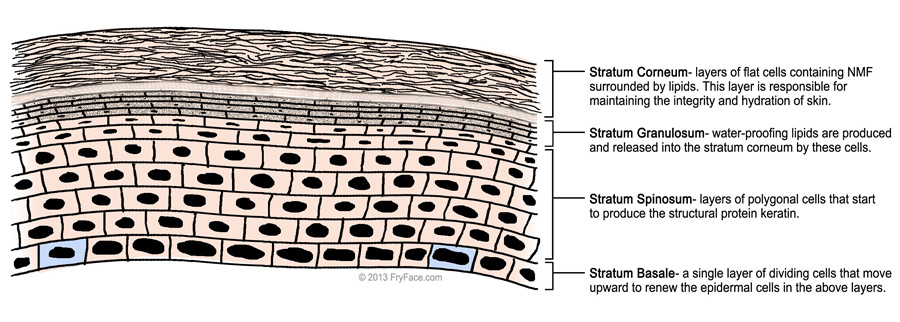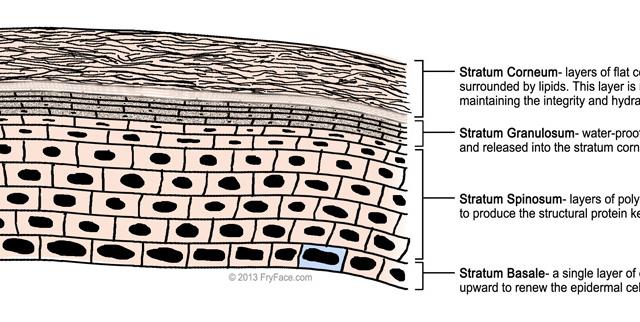If you want to expand your skincare routine beyond cleansing, moisturiser and sunscreen, exfoliation is a good next step. Exfoliating serums and scrubs boast that they can fight acne, clear your pores, reduce fine lines and make your skin vaguely brighter. Some of those promises are true, but they’re not the whole story. So here is your scientific, medically backed look at exfoliation: what it can (and can’t) do for your skin, and which effective, inexpensive products you can try out.
What is exfoliation?
Let’s start with a brief look at the top layer of your skin, the epidermis. New cells are born at the bottom of the epidermis, and the existing cells are pushed up toward the surface, where they eventually die. Their flattened out corpses stick around as the top layer of the epidermis, called the stratum corneum.
Those dead cells aren’t useless, though. They stick around because they’re important, serving as the barrier between you and the environment. The stratum corneum is what keeps you from being porous to the outside world, keeping moisture in and contaminants out. Eventually, though, as new cells are pushed up and die, the top layer of the stratum corneum sheds off.
Here’s an illustration of the layers of your epidermis (“NMF” is natural moisturizing factors):

The layers of the epidermis.
Exfoliation is the shedding of those cells. Healthy skin exfoliates on its own: Dr. Sandy Skotnicki, a board member of the Canadian Dermatology Association and author of the forthcoming book Beyond Soap, told me, that we get a new epidermis every 30 days.
But as we age, that process slows down. The dullness and flakiness we associate with dry skin is a failure of skin’s natural exfoliation. When too much of the stratum corneum hangs around, the cells clump into flakes and scales.
Exfoliating products hasten your skin’s natural process. This can be by physical means: scrubbing off the top layer of dead cells. Others exfoliate by chemical means: loosening the bonds between the dead cells so that they fall off more quickly. Done right, exfoliation really does live up to some of its promises. As Dr. Skotnicki put it, “Some sort of mechanical or chemical exfoliation can make your skin look a little bit more bright.”
Do you need to exfoliate?
Maybe. (Well, no one needs to exfoliate. This is about making your skin prettier, not healthier.) If you’re considering adding an exfoliating product to your skincare routine, though, first make sure you’re already using a good moisturiser.
Dr. Fayne Frey, whose site, FryFace, offers an excellent primer on the science of skin, told me that moisturiser is actually the best exfoliant. The cells of the stratum corneum are held together by chemical bridges called desmosomes. Those are naturally broken down by enzymes in your skin, which require water to function. “So,” Dr. Frey says, “The best way to exfoliate is to hydrate the skin.”
If you think about what you want from exfoliation — softer, brighter, smoother skin — that’s also what well-moisturized skin looks like.
[referenced url=”https://www.lifehacker.com.au/2016/09/how-to-choose-the-best-facial-moisturizer-for-healthy-skin/#_ga=2.147414647.1137332466.1520954313-1316224162.1502479853″ thumb=”https://i.kinja-img.com/gawker-media/image/upload/t_original/euaqyhtqv16hsiyccoxw.jpg” title=”How To Choose The Best Facial Moisturiser For Healthy Skin” excerpt=”Flaking, itching, taught and drab-looking skin are just no fun. Some, like yours truly, struggle with it more than others. We can blame our genes up to a point, but there’s a lot we can do on our own for good-looking skin, like following a skin care routine that includes moisturising.”]
If you’re in your twenties, you probably don’t need to exfoliate at all. Your skin is still churning out new cells on the regular. If you’re already moisturizing and still feel like your skin could be better, Dr. Skotnicki says your best bet is a chemical exfoliant like glycolic acid.
But if you’re dealing with bad acne, skin conditions like eczema or rosacea, or more serious concerns, everyone I spoke with agreed: you should go see a doctor. Most chemical exfoliants are pretty gentle — they’re sold as cosmetics, not drugs — but they can still be irritating to very sensitive or damaged skin. And they’re not strong enough to fix serious problems.
Wait, but what about scrubs?
Physical exfoliants like scrubs are what many of us are most familiar with, and there’s something satisfying about being able to feel exfoliation happening. Or at least feeling like you can feel it. But physical exfoliants are not a great idea, for two main reasons.
First of all, many physical exfoliants are made with plastic microbeads, which are terrible for the environment. Second, your goal is to loosen or break down the bonds between skin cells, which happens at a very small scale. With a physical scrub, it’s too easy to end up abrading your skin instead, causing tiny injuries.
According to Dr. Skotnicki, exfoliating by scrubbing is never good for the skin on your face, and it’s especially dangerous if you have acne, or other kinds of inflammation in your skin.
Craving the purifying feeling of a physical scrub is a lot like thinking you need to be squeaky-clean — it’s overkill, and has more to do with a psychological sense of cleanliness than an actual measure of efficacy.
All About Acids
Instead of scrubs, consider chemical exfoliants. They fall into two categories — alpha hydroxy acids (AHAs) and beta hydroxy acids (BHAs). Dr. Annie Chiu, a Board-Certified Cosmetic and General Dermatologist, told me that BHAs are good for people with oily or acne-prone skin, because they’re oil soluble.
The standard BHA is salicylic acid, which you’ll find in many drugstore anti-acne products (though for exfoliation you’ll use it on your whole face rather than as a spot treatment). On the other hand, AHAs are beneficial for people with dry skin because they act as humectants, drawing water into the skin (from either the dermis or, if you’re in high humidity, the air)
AHAs come in many varieties: lactic acid, glycolic acid, mandelic acid, and others. The dermatologists I spoke to preferred glycolic acid for its humectant properties and solid track record. There is also speculation that as glycolic acid speeds up cell turnover, it stimulates activity deeper in your skin, leading to more collagen production, which slows the formation of wrinkles.
However, for all these benefits, all the doctors I spoke with agreed that chemical exfoliants should only be used once or twice a week. This contradicts both many products’ use instructions and many users’ sense that more is better. Dr. Skotnicki says, “If you ask most dermatologists, [our patients] want to exfoliate too much, they want to scrub too much, they want to clean too much, and your body actually does it for you. You don’t need to help it along too much.”
“Skin is an organ,” Dr. Frey points out. “I know we all think of it as this thing of beauty, but it serves a purpose.” That purpose is protective, and exfoliation means chipping away at your defences. Remove the very top layer of cells and you’ll reveal fresher, glowier cells beneath. Remove too much, though, and you’ll not only leave your skin red and irritated, but you’ll also leave your body open to pollution and other contaminants — and you’ll make it too easy for your skin to lose moisture to the air.
And remember: that moisture is what keeps your skin looking its best.
How to shop
Dr. Skotnicki recommends products with as few ingredients as possible, advice that aligns with a major trend in skincare. It allows some brands to make their products less expensive. Dermatological science is only a starting point for finding the right products, so an important aspect of skincare is trying out products to see how they affect your own skin. Low prices make more experimentation feasible.
When products have more active ingredients, it’s harder to know if any benefits you see are from exfoliation or the other components. For example, some products contain polysaccharides, large sugar molecules, which Dr. Skotnicki told me draw moisture into the skin. That gives you an immediate or overnight plumping effect, which makes your skin look great and diminishes the look of fine lines, but the effects are temporary.
On the other hand, benefits are benefits. The doctors I spoke with highlighted the difference between products that functionally change your skin — which have to be classified as drugs by the FDA — and products that improve skin’s appearance. The latter is often temporary and does nothing to make your skin healthier, but temporary improvements in appearance are often all that a skincare devotee is looking for, and that’s OK.
You can also look for higher concentrations of acids. These products are often labelled as peels or masks and they’re rinsed off after a prescribed period of time, usually 2-10 minutes.
As with any skincare product, start slowly and work your way up. You can do a patch test on your inner arm or behind your ear to check for an allergic reaction to a new product. Then, especially if you’re new to exfoliating, start with once a week and see how your skin reacts. You can work up to two-three times a week for an exfoliating serum and once a week should be enough for an at-home peel or mask.
More is not necessarily better. You only have so much dead skin to slough off! And you need some of it for protection!
Chemical exfoliants make your skin extra sensitive to sunlight, so make sure you’re wearing a daily sunscreen. It should be broad-spectrum, SPF 30 or higher. But really, you should be doing that every day.
Still, don’t expect miracles. Dr. Skotnicki says, “60 per cent of ageing is genetics. 30 per cent is whether you smoke and how much sun you get. And 20 per cent is products. [But] no product will stop ageing. It’s going to slow it. If you want to turn back the years, you have to have plastic surgery or something like that. Everything else is just slowing the clock and you only get about 20 per cent leeway.”
Exfoliation is a part of that 20 per cent. It’s not going to dramatically change your skin (or your life), but it’s one of the few components of a skincare regime that’s backed up by science. So knock yourself out — gently, and only once or twice a week.

Comments